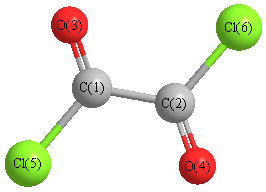Vibrational Frequencies calculated at TPSSh/aug-cc-pVDZ
| Mode Number |
Symmetry |
Frequency
(cm-1) |
Scaled Frequency
(cm-1) |
IR Intensities
(km mol-1) |
Raman Act
(Å4/u) |
Dep P |
Dep U |
|---|
| 1 |
Ag |
1813 |
1754 |
0.00 |
|
|
|
| 2 |
Ag |
1042 |
1008 |
0.00 |
|
|
|
| 3 |
Ag |
604 |
584 |
0.00 |
|
|
|
| 4 |
Ag |
417 |
403 |
0.00 |
|
|
|
| 5 |
Ag |
279 |
270 |
0.00 |
|
|
|
| 6 |
Au |
375 |
363 |
14.62 |
|
|
|
| 7 |
Au |
19 |
18 |
0.70 |
|
|
|
| 8 |
Bg |
714 |
691 |
0.00 |
|
|
|
| 9 |
Bu |
1843 |
1783 |
425.25 |
|
|
|
| 10 |
Bu |
747 |
723 |
522.02 |
|
|
|
| 11 |
Bu |
478 |
463 |
7.45 |
|
|
|
| 12 |
Bu |
195 |
188 |
3.78 |
|
|
|
Unscaled Zero Point Vibrational Energy (zpe) 4263.2 cm
-1
Scaled (by 0.9673) Zero Point Vibrational Energy (zpe) 4123.8 cm
-1
See section
III.C.1 List or set vibrational scaling factors
to change the scale factors used here.
See section
III.C.2
Calculate a vibrational scaling factor for a given set of molecules
to determine the least squares best scaling factor.
Charges, Dipole, Quadrupole and Polarizability
Charges from optimized geometry at TPSSh/aug-cc-pVDZ
Charges (e)
| Number |
Element |
Mulliken |
CHELPG |
AIM |
ESP |
| 1 |
C |
0.351 |
|
|
|
| 2 |
C |
0.351 |
|
|
|
| 3 |
O |
-0.335 |
|
|
|
| 4 |
O |
-0.335 |
|
|
|
| 5 |
Cl |
-0.016 |
|
|
|
| 6 |
Cl |
-0.016 |
|
|
|
Electric dipole moments
Electric dipole components in Debye
(What's a Debye? See section
VII.A.3)
| |
x |
y |
z |
Total |
| |
0.000 |
0.000 |
0.000 |
0.000 |
| CHELPG |
|
|
|
|
| AIM |
|
|
|
|
| ESP |
|
|
|
|
Electric Quadrupole moment
Quadrupole components in D Å
Polarizabilities
Components of the polarizability tensor.
Units are
Å
3 (Angstrom cubed)
Change units.
| |
x |
y |
z |
| x |
10.948 |
2.079 |
0.000 |
| y |
2.079 |
10.174 |
0.000 |
| z |
0.000 |
0.000 |
5.710 |
<r2> (average value of r
2) Å
2
| <r2> |
247.097 |
| (<r2>)1/2 |
15.719 |
